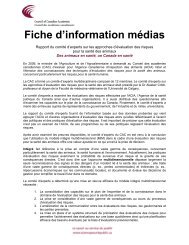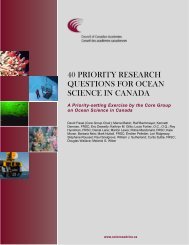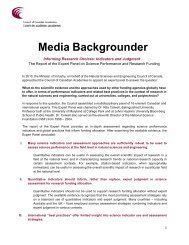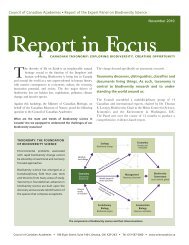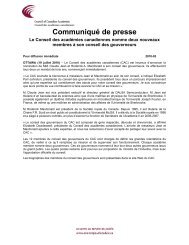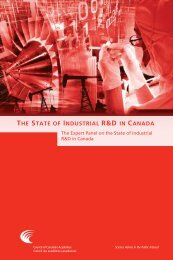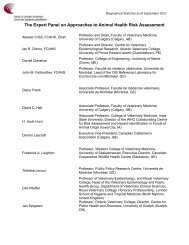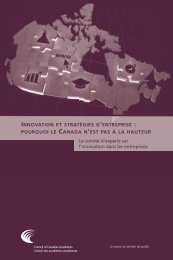an assessment of the evidence - Council of Canadian Academies
an assessment of the evidence - Council of Canadian Academies
an assessment of the evidence - Council of Canadian Academies
- No tags were found...
Create successful ePaper yourself
Turn your PDF publications into a flip-book with our unique Google optimized e-Paper software.
Influenza Tr<strong>an</strong>smission <strong>an</strong>d <strong>the</strong> Role <strong>of</strong> PPRE: An Assessment <strong>of</strong> <strong>the</strong> Evidence 5required to cause infection during a p<strong>an</strong>demic because <strong>of</strong> <strong>the</strong> absence <strong>of</strong> priorimmunity. This may also me<strong>an</strong> that infected persons shed virus in higherconcentration or for longer periods <strong>of</strong> time. These factors could increase <strong>the</strong> risk<strong>of</strong> tr<strong>an</strong>smission, but it is not known if <strong>the</strong>y would alter <strong>the</strong> relative contribution <strong>of</strong>different modes <strong>of</strong> tr<strong>an</strong>smission as between p<strong>an</strong>demic <strong>an</strong>d seasonal influenza.Conclusions on Modes <strong>of</strong> Influenza Tr<strong>an</strong>smission1. Ballistic, nasopharyngeal, tracheobronchial <strong>an</strong>d alveolar-sized particlesare all emitted from <strong>the</strong> hum<strong>an</strong> respiratory tract.2. Evidence about <strong>the</strong> relative contribution <strong>of</strong> <strong>the</strong> different modes <strong>of</strong>tr<strong>an</strong>smission to <strong>the</strong> spread <strong>of</strong> influenza is sparse <strong>an</strong>d inconclusive.3. There is <strong>evidence</strong> that influenza is tr<strong>an</strong>smitted primarily at short r<strong>an</strong>ge.4. There is <strong>evidence</strong> that influenza c<strong>an</strong> be tr<strong>an</strong>smitted via inhalation <strong>of</strong>tracheobronchial <strong>an</strong>d alveolar-sized particles at short r<strong>an</strong>ge.5. There is <strong>evidence</strong> that deposition <strong>of</strong> nasopharyngeal-sized particles in <strong>the</strong>upper respiratory tract c<strong>an</strong> cause infection.6. There is <strong>evidence</strong> that contact tr<strong>an</strong>smission c<strong>an</strong> occur. The current weight<strong>of</strong> <strong>evidence</strong> suggests that tr<strong>an</strong>smission <strong>of</strong> influenza by inhalation is moreprobable th<strong>an</strong> by indirect contact.7. The <strong>evidence</strong> is lacking to determine whe<strong>the</strong>r long-r<strong>an</strong>ge tr<strong>an</strong>smission <strong>of</strong>influenza occurs, but it c<strong>an</strong>not be ruled out.PROTECTIVE MEASURES AGAINST INFLUENZA TRANSMISSIONThe only interventions that have been tried <strong>an</strong>d shown unequivocally to reduce<strong>the</strong> spread, <strong>an</strong>d to mitigate <strong>the</strong> impact, <strong>of</strong> influenza in populations are vaccines<strong>an</strong>d <strong>an</strong>tivirals. O<strong>the</strong>r interventions are never<strong>the</strong>less needed because vaccinationwill not be 100 per cent effective, <strong>an</strong>d because a vaccine is unlikely to be availableduring <strong>the</strong> first wave <strong>of</strong> a p<strong>an</strong>demic.Public health, <strong>an</strong>d occupational health <strong>an</strong>d safety practitioners use a multi-component“hierarchy <strong>of</strong> control” when developing infection control measures for <strong>an</strong>y disease.The hierarchy comprises three categories – engineering controls, administrativecontrols <strong>an</strong>d personal protective equipment (PPE). No one category is intended to





